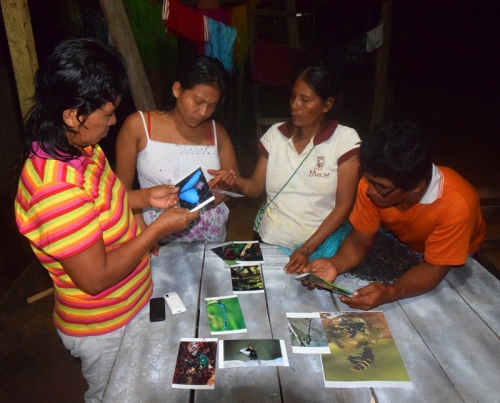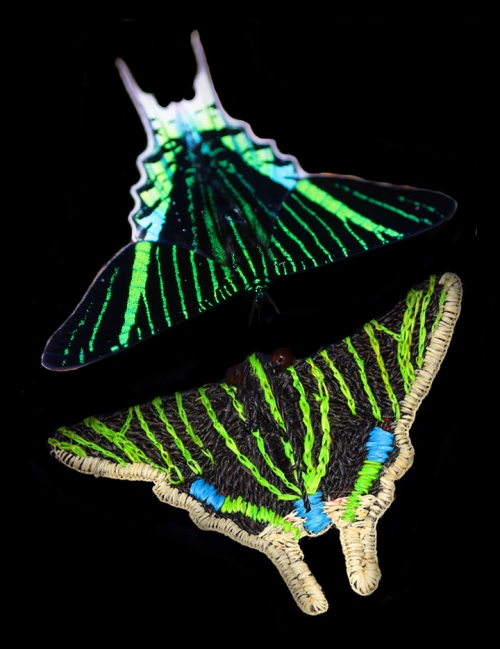
Chambira Association of Jenaro Herrera – Dora, Hilda and Doilith. Photo by Campbell Plowden/Center for Amazon Community Ecology
In the summer of 2007, the Center for Amazon Community Ecology began its second summer of field work researching the ecology and sustainable harvest of copal resin at a research station on the outskirts of Jenaro Herrera – a town of 5,000 people reached by a 12-hour ferry ride up the Ucayali River from Iquitos. On one trip to town, I met Dora and her “family” of artisans and bought an assortment of their shicras (shoulder bags that were loosely woven with chambira palm fiber) and seed jewelry to bring back to the U.S. Their handicrafts were similar to ones made by many other artisans in the region so I asked them how they thought they might make their crafts more distinctive.

Miniature woven pot ornament. Photo by Campbell Plowden/CACE
Dora volunteered, “I could sew a satiny lining into a chambira bag – what about red?” Great, let’s try it! My 17-year old daughter Marissa who was with me on that trip suggested the idea of making a chambira choker decorated with achira seeds. Dora’s “aunt” Hilda said, “I could make that.” We then walked out to their fields to watch them collect oblong-shaped pashaco seeds to accent some longer necklaces. Several weeks later we got some well-made examples of the standard crafts and some examples of the new ones.
Our sales of earrings made by other artisans from Jenaro Herrera did well, but the new woven crafts made by Dora and her relatives hadn’t yet struck a chord. After some Christmas tree ornaments made by artisans from the Ampiyacu region began to sell well, I brought the challenge to Dora and her group. We brainstormed different ideas, and they decided to try making colorful miniature versions of the woven baskets and plates that were usually 8 to 12 inches across. Doilith who was a younger relative that had recently joined the group made chambira stars with black and red seeds in the five points and center.

Artisan Rosa Mozombite from Jenaro Herrera with chambira insect ornaments. Photo by Campbell Plowden/Center for Amazon Community Ecology
It was encouraging to see that people liked many of these ornaments, but the spark of success came the following summer when Dora modestly told me, “My daughter Rosa has woven some critters that I think you will like.” It was a wonderful understatement. Arriving at her house, I marveled at the first examples of a butterfly, bee and dragonfly that she had woven from chambira. The normally shy teenager beamed when I asked her if I could take her picture displaying her creative efforts.
Over the next few years, we experimented with different colors, models and sizes of these unique insect ornaments. It didn’t take long to figure out that people buying one for their Christmas tree or a gift much preferred ones with bright colors like yellow and orange to dark ones and generally liked small to medium sized-ones more than giants. We gradually improved, but Dora and friends produced some batches that still mostly sit in boxes because I failed to understand that certain Spanish words for colors are different from their English equivalents and their meanings may vary from region to region.

Chambira Association of Jenaro Herrera – Dora, Hilda and Doilith. Photo by Campbell Plowden/Center for Amazon Community Ecology
I appreciated that in spite of these glitches in communication, the Association of Chambira Artisans as they now called themselves worked very diligently to comply with any craft order and were always ready to discuss and try new ideas. They in turn appreciated that while CACE was their only regular craft buyer once or twice a year, these sales were making a difference in their lives. When I got to Jenaro Herrera in the summer of 2014, I noticed that Dora’s house was completely new. She said, “thanks to making these ornaments, Eliazar and I were able to buy enough wood and palm thatch to put up new walls and a roof.”
While the Dora group will continue using their imagination to make new crafts, we are now trying to develop some chambira ornaments based on actual species of Amazon insects. They have made good-looking models of the blue morpho butterfly, scarlet peacock butterfly, (day-time flying) uranid moth, and the Amazon darner dragonfly. Attempts to make a bright green orchid bee and yellow and red tailed “ronsapa” bee that are important pollinators and collectors of copal resin are still in progress.

Amazon butterflies and chambira ornaments. Ornament photos by Campbell Plowden/Center for Amazon Community Ecology.
Since Rosa left town, Doilith has become the master weaver of these new critters. She said, “I love the challenge of trying to figure out how to make the details of these beautiful little animals that live in our forests. Before we started making insects ornaments, I wasn’t really aware that they have six legs instead of four. My goal now is to bring them to life as best as I can so people can have a better understanding of our art, culture, and nature in the Peruvian Amazon. Making crafts is already helping my family meet its needs, and (placing her hand gently on her tummy) I’ve got another baby on the way.”

Artisan Doilith del Castillo from Jenaro Herrera with butterfly ornaments. Photo by Campbell Plowden/Center for Amazon Community Ecology

Dora and family examining insect photos to make ornaments. Photo by Campbell Plowden/Center for Amazon Community Ecology.

Amazon darner dragonfly and ornament. Photo by Campbell Plowden/Center for Amazon Community Ecology

Scarlet peacock butterfly (Anartia amathea) and chambira ornament. Photo by Campbell Plowden/Center for Amazon Community Ecology.

Uranid moth and ornament. Photo by Campbell Plowden/Center for Amazon Community Ecology.

Blue morpho butterfly ornament. Photo by Campbell Plowden/Center for Amazon Community Ecology.

Comments will be approved before showing up.


